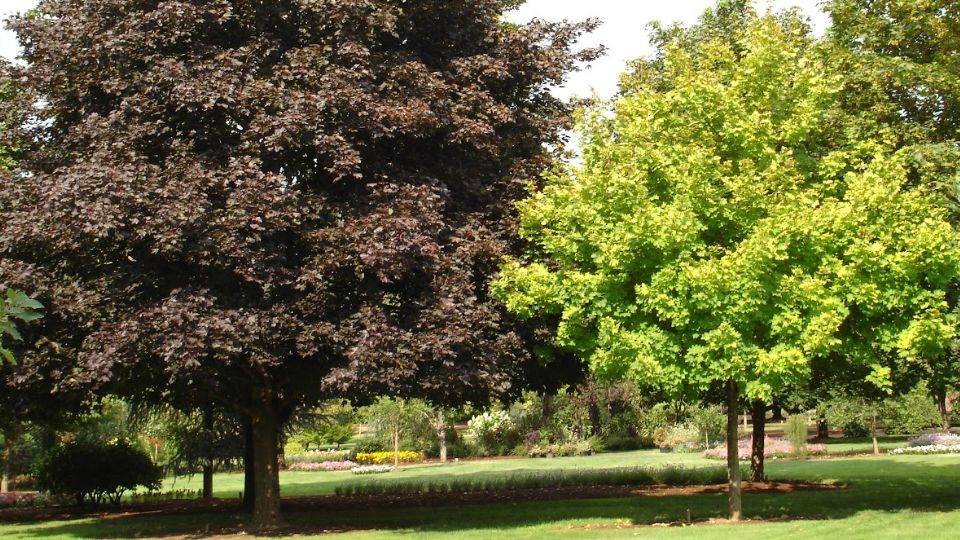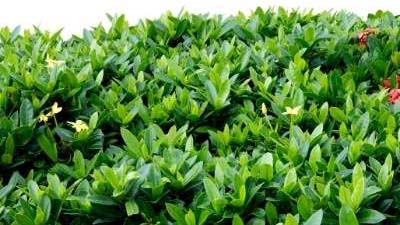Collecting Plants on Public Lands for Utah Landscaping
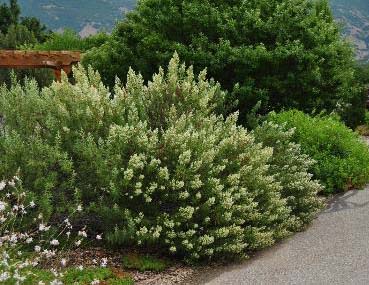
Utah is a state of environmental extremes ranging from red rock deserts to alpine meadows. Amazingly, there are native plants adapted to virtually all the environments in the state. These wonderful plants range from flowering penstemons (more than 100 species or subspecies in Utah) to iconic trees like the bristlecone pine. The adaptation of these plants to local soils, moisture, temperatures, and pests make them prime candidates for sustainable, low-water landscaping that also fosters habitat for pollinators and wildlife (Fig. 1).
Many Utah natives are available at local nurseries where they can be purchased for planting in landscapes. A much less convenient, though more adventurous, way to obtain native plants is to collect them from wild areas of the state. Much like rock collecting, hunting, or fishing, collecting plants can be a great way to enjoy the beauties of Utah and enhance appreciation for our local environment. At the broadest level, it may include collection of seeds, cuttings, boughs, seedlings, or entire plants.
Collecting, transplanting, and establishing native plants in a landscape are not easy and there exists a high risk of the plants dying. In this sense, plant collecting is very different than something like rock collecting where the collectable is found, tossed in a bucket, and can be ignored without consequence. Once a native plant is collected from the wild, it is dependent on the collector to keep it alive until it is fully established in a landscape. Collectors should prepare to keep plants alive during collection and establishment. This includes planting them in a spot in the landscape where they can thrive. If you do not think you can keep a plant alive (and it can be challenging), then it is best just to collect seeds rather than whole plants.
Just as with hunting, fishing, or rockhounding, there are regulations for plant collecting. These include rules as to where and what plants can be collected. Collectors should be aware that regulations vary by agency and even location within an agency’s jurisdiction. In some cases, appropriate permits may be required. Regulations vary with the type of plant material being collected and its ultimate intended use.
Regulated plants or plant materials include seed, fruit, firewood, Christmas trees, boughs, fence posts, and transplants (wildings). When collecting material for landscaping, typically it would include seed, cuttings, and/or transplants. Seed collection has the least impact on individual plants because they will be dropping the seed anyway. But, it can have an impact on species populations and, thus, the overall environment over time. Collecting cuttings actually involves cutting parts off the parent plant, but it can be done in such a manner that it has no more impact than a wandering deer browsing a branch. Collecting transplants has more impact because the entire plant is removed from the landscape. Typically, small amounts of seed can be collected free, whereas collecting whole plants usually involves some type of fee.
Plant collection can be divided into three categories: recreational use, personal use, and commercial use. Typically, commercial use involves large quantities of material and its resale into the commercial market. Personal use involves collecting smaller quantities, but still significant amounts, such as transplants for use in a home landscape. Recreational use is largely incidental collecting associated with camping or other activities or seasonal collection of relatively small quantities of pine nuts or fall foliage. Recreational use is the least regulated collecting category while commercial use involves the most extensive regulation and permitting requirements. This fact sheet focuses on collection for recreational or personal use only.
Please be aware that emergency restrictions may be placed on any resource collection due to drought, fire, or other natural event that may require protection of the resource until populations can be restored. Such information is best obtained from the local agency managing the property.
Collection Area Options
Native, wild plants can be found in almost all locales within the state outside of developed, urban areas. While such plants do not defer to political or property boundaries, those who may be interested in collecting them should adhere to the regulations unique to their location. A diverse group of public agencies, including the following, manage these lands.
- State of Utah
- School and Institutional Trust Lands Administration (SITLA)
- Utah Division of Natural Resources State Parks (DNR State Parks)
- Utah Division of Wildlife Resources (DWR)
- United States Department of Interior
- Bureau of Indian Affairs (BIA)
- Bureau of Land Management (BLM)
- Bureau of Reclamation (Reclamation)
- National Park Service (NPS)
- United States Fish and Wildlife Service(FWS)
- United States Department of Agriculture
- Forest Service (USDA-FS)
- Other federal lands
- National monuments, historic sites, and historic trails
- Private lands
Maps showing the boundaries of these various groups can be found in many places. A good option is https://trustlands.utah.gov/download/maps/statewide/SurfaceMineral_st36x48_shd.pdf.
Specific Agency Requirements
School and Institutional Trust Lands Administration (SITLA)
The trust lands administered by SITLA are set apart to provide economic support for public education. Currently SITLA does not have a published policy on plant collecting. However, they do have one on rock collecting (http://trustlands.utah.gov/wp-content/uploads/2014/01/Rockhounding.pdf). Based on that publication, individuals interested in collecting plants on SITLA administered lands should obtain a permit from one of their offices (https://trustlands.utah.gov/wp-content/uploads/2017/05/2360-Rockhounding-Permit-Form.pdf). Currently, rock-collecting permits for personal use are $10 per individual or family for one year.
Utah Division of Natural Resources State Parks (DNR State Parks)
All plants in Utah State Parks are protected and collection is prohibited.
Utah Division of Wildlife Resources (DWR)
Removal of any plant material is prohibited except as authorized. Regulations specifically allow the purchase of one permit per year to remove woody ornamental plants within the boundaries of lands managed by the DWR (https://wildlife.utah.gov/wildlife-news/46-rules/rules-regulations/961-r657-28-use-of-division-lands.html). Permits are offered for conifers ($5) and deciduous trees ($3) at regional DWR offices.
Bureau of Indian Affairs (BIA)
One of the BIA’s responsibilities is to assist in the management of lands administered by federally recognized Native American tribes. All tribal lands should be treated as private property and plant material should not be collected without written permission from the appropriate authorities. Because of tribal sovereignty, regulations may vary between different reservations.
Bureau of Land Management (BLM)
Plant collecting on BLM lands is managed at the district, state, and federal level with overlapping policies and regulations. It is important to recognize that there are minimum statewide policies and these policies can be augmented by local district policies. Each district has its own permitting system (https://www.blm.gov/programs/natural-resources/forests-and-woodlands/forest-product-permits). In Utah, non-commercial use is defined as either recreational or personal. In general, recreational use is the collection of reasonable amounts (about 1 pound) of renewable resources such as flowers, berries, nuts, cones, and leaves and does not require a permit. Personal use is for larger amounts, may be non-renewable (such as an entire plant), and requires a permit. Materials collected for recreational or personal use cannot be bartered or sold.
Permits for collecting can be obtained at district BLM offices. In general, the regulations are as follows:
- Any transplant collection requires the purchase of a permit.
- Personal use is defined as less than 10 trees or less than 20 shrubs, grasses, cacti or other plants per year.
- Tree permits cost $2 per foot or a minimum of $10 per tree. • Shrubs and cacti are $2 each.
- Grasses and wildflowers are $1 each.
- In general, in wilderness or wilderness study areas, collecting plant material is not permitted.
- Vehicle travel is restricted to existing roads.
- Up to 5 gallons of berries or cones and 25 pounds of boughs or greenery (including cuttings for propagation) per species can be collected without a permit. Up to 25 pounds of pinyon nuts can also be collected.
Bureau of Reclamation (Reclamation)
Reclamation is charged with managing the land and water associated with the many federal dams and other water projects that have been built throughout the west. These lands are administered by Reclamation, or any of a number of city, county, state, and other federal agencies. Collecting should follow regulations of the administering office. For those lands administered by Reclamation, renewable resources (such as berries or nuts) may be collected for personal use only.
National Park Service (NPS)
Collection of native plant material in national parks is prohibited unless specifically authorized by the National Park Service. In essence, it should be assumed that collection of any plant material in a national park is prohibited.
National Monuments, Historic Sites, and Historic trails
National monuments such as Bears Ears, Cedar Breaks, Dinosaur, Grand Staircase-Escalante, Hovenweep, Natural Bridges, Rainbow Bridge, and Timpanogos; as well as national historic sites and historic trails are managed by various federal agencies such as the NPS, USDA-FS, and/or BLM.
Policies on plant collecting vary with the monument or site as determined by the managing agency through processes such as Environmental Impact Statements. Collecting at any of these sites should follow the policies of the managing agency for the specific monument or site.
United States Fish and Wildlife Service (FWS)
The U.S. Fish and Wildlife Service does not have a specific policy for collecting live plants. However, they do have a policy for collecting firewood and miscellaneous materials. All such activities require a permit (https://www.fws.gov/permits/ and https://www.fws.gov/forms/3-1383-G.pdf).
USDA Forest Service (USDA-FS)
Like the BLM, the USDA-FS has overlapping jurisdictions and regulations at the District, Forest, Region, and National levels. Permits may be required and can be obtained at USDA-FS District Offices (https://www.fs.fed.us/wildflowers/ethics/permit.shtml). Permits for personal-use are a minimum of $20 and are good for 1 year. The District Ranger usually decides the number of permits available at a local level. Some forests near populated areas (such as the Uinta-Wasatch-Cache National Forest) require permits or authorization for the removal of any forest product (see https://www.fs.usda.gov/main/uwcnf/passes-permits/forestproducts as an example). Plant species designated as Forest Service Sensitive (FSS) or Watch List should not be collected. In addition, no plant material may be removed from Research Natural Areas, Special Interest Areas, Wilderness Areas, developed recreation sites, and high use sites such as the lower Logan canyon area.
Private Lands
Plants growing on private property belong to the property owner and should not be collected without permission of the owner. Property owner names can be obtained through county ownership maps or public/private land ownership apps. In regards to federally protected plants growing on private property, they also belong to the property owner who may do with them as they please unless there is a state or local law prohibiting such activity. That being said, it is important to realize that endangered plants and habitats should always be protected and there are laws against commerce with federally protected plants.
Collecting and Handling Plant Material
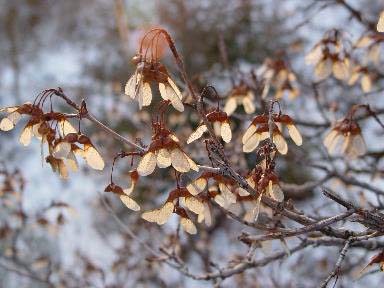
Collecting wild plants can be very enjoyable as a family recreational activity or as a more intensive quest for unusual specimens. Regardless of the level at which it is pursued, it is not much fun if the plants die. Whether collecting whole plants, cuttings, or seed (Fig. 2), there are several steps to success. The more attention a collector can give these details, the greater the chances the plant will survive and be an attractive addition to the landscape.
What to collect
The first step in plant collecting is to decide what to collect. Simply collecting plants with the idea of creating a natural or wild landscape will not be as effective as developing a plan and specifying plants within that plan. Determining which plants to use can be done by observation the wild or reviewing references such as those shown in Appendix A. A very effective approach would be to have a landscape design done with the plants identified. Plants identified as natives could then be collected. In addition, it is possible to identify native plants that could act as substitutes for non-natives identified in the plan. Again, it is important to avoid collecting threatened or endangered plant species as identified in lists published by the U.S. Fish and Wildlife Service (see: https://dwrcdc.nr.utah.gov/ucdc/ViewReports/te_list.pdf).
Where to collect
The next question becomes where to collect the plant of interest. The location of native plants can be determined by various academic sources(Appendix A), or by word-of-mouth or observation. Once the location of a plant is found, then it is a matter of identifying the land manager and getting the appropriate permits or approvals.
Travel on public lands
It is important that both the collector and the plant survive. Remember that most plants will be collected in back country areas with limited services and, consequently, appropriate travel precautions should be taken. At a minimum,these precautions should include transportationsuitable to the area, survival equipment in case of emergency, and leaving word with someone as to where you will be and when you are expected to return. Winter is often the best time for collecting because the plants are dormant.But, that means traveling on unimproved roads under potentially inclement conditions, which further emphasizes the need for appropriate equipment and planning.
When to collect
Successfully collecting plants or plant parts for propagation is greatly improved when done at the right season. While the following table gives a rough approximation of the best times, it is important to note that optimum times vary with the species and the type of material collected. When collecting entire plants (both stems and roots) it should be done when plants are dormant. This can be late fall for herbaceous perennials, or usually winter for woody plants. Seeds should be collected when they are fully ripe, but before being dropped by the plant, regardless of the time of year.
| Type of Material Collected | J | F | M | A | M | J | J | A | S | O | N | D |
|---|---|---|---|---|---|---|---|---|---|---|---|---|
| Woody plant transplants | Y | Y | Y | Y | Y | |||||||
| Herbaceous perennial transplants | Y | Y | Y | Y | Y | Y | Y | |||||
| Seeds | Y | Y | Y | Y | Y | Y | Y | Y | Y | Y | Y | Y |
| Softwood cuttings | Y | Y | Y | |||||||||
| Hardwood cuttings | Y | Y | Y | Y | Y | |||||||
| Scion wood | Y | Y | Y | Y | Y |
Collecting equipment and supplies
Collecting seed
Of all the ways to collect plants, seeds are the easiest as they come in a prepackaged form. However, they still need to be handled correctly. Most seed should be kept cool and dry until it can be processed. Tools and materials needed for seed collection could include the following:
- Containers for dry storage made of paper (envelopes), nylon mesh, cotton, burlap, or other materials
- Hand shears
- Magnifying glass
- Tarps or blankets
- Gloves
Collecting cuttings
Cuttings typically consist of pieces of stems or roots. Depending on the plant and the season, they can be challenging to handle because as soon as they are cut from the mother plant they begin to dry. If allowed to dry too far, they will die. In general they need to be kept cool and moist until they can be further processed. Helpful equipment includes:
- Hand shears or knives
- Plastic bags and ties
- Paper towels
- Water
- Cooler with ice
Collecting transplants
Collecting whole plants requires digging them out of the soil. Depending on the area, digging may include dealing with rocks and it may require cutting roots that are too deep to dig. It is also necessary to have some way keeping the plant moist and transporting it. In general, equipment should include the following:
- Shovel
- Pick
- Pry bar
- Loppers
- Pruning saw
- Hand trowel
- Containers (pots)
- Water
- Temporary rooting medium(sawdust or potting soil)
- Twine
- Cooler or plastic bags
- Paper towels
Collection records
It is always a good idea to record where and when the plant was harvested. Landscape plants are usually more enjoyable if there is a story behind the plant. It also makes them more valuable to family members over the years. As with most recreational activities, it is also fun to have a photographic record of the event.Materials for effective record keeping include:
- GPS for latitude and longitude of source
- Camera
- Field notebook
- Labels
- Permanent marker
Keeping plant material alive
The following are general guidelines for working with plant materials. Each species has different requirements for successfulpropagation. To determine the best protocol for each situation, research should be completed using references such as those listed in Appendix A. In general, the sooner plants are are stuck into rooting media, grafted, or trans-planted, the greater the chances for success.
Seeds
Seeds are easily collected and stored in a cloth or paper bag until they can be planted. Long term storage should be done with dry seeds in an airtight container held in a cool, dark environment. Many wild plants have complex dormancy requirements that may need to be overcome prior to planting and germinating the seed.
Cuttings
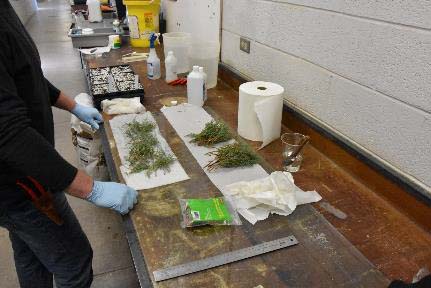
Dormant or hardwood cuttings are easy to handle and can be stored by keeping them cool and moist until stuck in a rooting environment. In general, wrapping in moist paper towels, placing in a sealed plastic bag, and keeping refrigerated will suffice.Softwood, or leafy cuttings must be kept refrigerated and moist until stuck in a rooting environment that will keep them alive until new roots form. Leafy cutting sare very susceptible to drying out and great care must be taken to keep them alive and healthy (Fig. 3).
Scion wood
Woody plants such as pines or maples can be successfully propagated by grafting to plants already growing in the landscape or nursery. While grafting can be successful,there are often a number of steps that must be carefully followed, so using published protocols is recommended. Scion wood, like cuttings, should be kept cool and moist until used.
Wild transplants
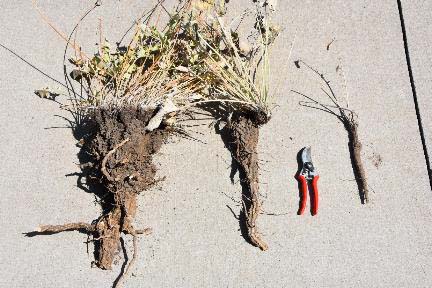
When collecting transplants, it is a good idea to store and transport the plants in a cooler filled with ice. Even then, it is important to get the plants to a place where they can be properly cared for. The sooner collected plants can be replanted in a container or landscape, the greater their chances for survival. It is critical that a method of transporting the plants and an option for transplanting be prepared prior to collecting.If transplanting options are not prepared ahead of time, the risk of damage due to water stress or neglect increases greatly. In general, if plants are dormant the risks are much less than a plant with leaves. If leaves are present, care must be taken to avoid transplant shock by transplanting to a container and then placing in a cool, shady spot until they are fully recovered.
A big challenge in transplanting whole tree or shrub wildlings is retaining enough roots to keep them alive. Simply stated, the more of the original root system that can be retained, the greater the chances for survival.But, the bigger the root system, the more work it will take to dig it up. With herbaceous plants like perennial flowers or grasses, it is fairly easy to harvest a substantial portion of the root system. Large trees or shrubs have large root systems, so in general it is best to select small plants less than a foot or two in height. Unlike commercially grown plants with compact,fibrous root systems, wild plants often have widely spread roots with deep taproots. It is impossible to retain all the roots, and a decision will have to be made that balances plant survival with the time and effort available to excavate the root system (Fig.4).
Native plants can be dug either with a rootball or as bareroot. A rootball means that the block of soil the roots are in is carefully excavated, wrapped, and then transported. It can be a lot of work because soil is heavy. Enough soil to fill just a 5-gallon pot weighs roughly 50 pounds. Bareroot plants are dug with as much of the root system as possible, but there is no attempt made to keep the soil around the roots. Bareroot plants are much lighter and easier to handle, but the plant must be dormant (at least for woody species). Also, the roots cannot be allowed to either dry out or be stored in water. The best way to transport them is to dig as much of the root system as possible and then plant it in a pot with a temporary potting mix such as moist wood shavings. This will keep the roots from drying out and also allow them access to oxygen until they can be transplanted to the landscape.
Restoring the collection site
The final step in collecting wild plants is to restore the collection site to its original condition. Cuttings should be taken in a manner that preserves the form and appearance of the mother plant. Soil should be replaced and adjacent plants restored when plants are excavated. A general rule of thumb is that if noone can tell a plant was collected, then the site has been adequately restored.
Transplanting
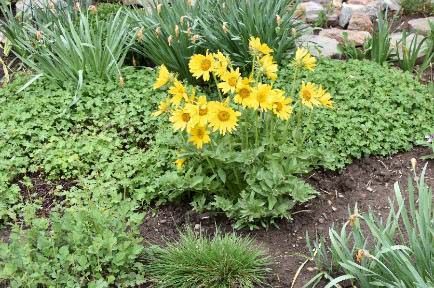
The final step is correctly transplanting the wild plant to the landscape. Transplanting can be done to either a container or the landscape, but in either case it should be done as quickly as possible. Plants grown in containers should also use a potting soil, not a field or native soil. Care should be taken to insure the plant is at the same depth in the soil as it was in its original location.With native plants, it is easy to assume that they are very tough and require minimum care. That may be true once they are established, but since the root system has been reduced, it is important to keep the soil moist until they have recovered from transplant shock (Fig. 5). However, native plants must also not be overwatered, or they may die. In general, using a good soil in the landscape and a good potting soil for containers will help keep plants vigorous and healthy.When growing plants in pots, wait following an irrigation until the surface of the potting media is dry to the touch before watering again.
Ethical Plant Collecting
Similar to any other mixed-use activity, it is important to realize that other people share the public lands where plants are collected and that collection should be done in an ethical fashion that conserves the collected populations and the site. The following guidelines should be kept in mind when collecting:
- Try and leave the native landscape so no one can tell plants were collected.
- Be careful of collateral damage – it is easy to injure plants adjacent to where collecting was done.
- Do not collect endangered plants or threatened plants. If you do not know whether a target plant is endangered, leave it alone.
- Do not poach plants – get the proper permits.
- Do your best to keep collected plants alive.That being said, some plants will die. Even under the best conditions with commercially grown nursery stock, it is common for 10% of transplanted plants to die. With wild transplants, the odds are the mortality rate will be higher. However, survival rates can be improved through proper management.
Having Fun!
Utah is a wonderfully diverse state with much to see and do. Careful collection of plants can be a great hobby and a very enjoyable form of outdoor recreation. In addition, there is nothing quite like being able to tell the story of how a plant was found, collected, transplanted and enjoyed.
Appendix A: Resources for Further Information
Descriptions and Locations of Native Plants
- Albee, B.J. 2002. Atlas of Vascular Plants of Utah. University of Utah Press, Salt Lake City, Utah.
- Andersen, B.A. Desert Plants of Utah. Revised 1996. Utah State University Extension. HG 505 https://digitalcommons.usu.edu/cgi/viewcontent.cgi?article=2011&context=extension_histall
- Andersen, B.A., and A.H. Holmgren. Mountain Plants of Northeastern Utah. Revised 1996. Utah State University Extension. HG 505. https://digitalcommons.usu.edu/cgi/viewcontent.cgi?article=1976&context=extension_histall
- 9 Anderson, R.M., J. Gunnell, and J.L. Goodspeed. 2012. Wildflowers of the Mountain West. University Press of Colorado. Boulder, Colorado.
- Brigham Young University Herbarium (http://www.herbarium.biobotany.net/)
- Larese-Casanova, M. 2014. Mountain Plants Field Book. Utah Master Naturalist. Utah State University Extension. https://extension.usu.edu/utahmasternaturalist/files/UMNP_Mountains_Plants_Book_pages.pdf
- Mee, W., J. Barnes, R. Kjelgren, R. Sutton, T. Cerny, and C. Johnson. 2003. Waterwise: Native Plants for Intermountain Landscapes. Utah State University Press. Logan, Utah https://digitalcommons.usu.edu/usupress_pubs/143/
- Pratt, M.S. Range Plants of Utah. Utah State University Extension. https://extension.usu.edu/rangeplants/[BROKEN LINK]
- Rupp, L.A., and A. Wheaton. 2014. Nurturing Native Plants. A Guide to Vegetative Propagation of Native Woody Plants in Utah https://digitalcommons.usu.edu/cgi/viewcontent.cgi?article=1793&context=extension_curall
- USDA-FS and Southern Regional Extension Forestry. Propagation Protocol Database. Reforestation, Nurseries, and Genetics Resources. https://npn.rngr.net/propagation
- USDA, NRCS. 2019. The PLANTS Database (http://plants.usda.gov, 4 January 2019). National Plant Data Team, Greensboro, NC 27401-4901 USA.
- https://plants.sc.egov.usda.gov/java/
- Utah Native Plant Society. https://www.unps.org/index.html?PAGES/links.html
- Utah State University Herbarium (https://herbarium.usu.edu/[BROKEN LINK])
- Utah Valley University Herbarium (http://herbarium.uvu.edu/)
- Van Buren, R.V., J.G. Cooper, L.M. Shultz, and K.T. Harper. 2011. Woody Plants of Utah: A Field Guide with Identification Keys to Native and Naturalized Trees, Shrubs, Cacti, and Vines. Utah State University Press, Logan, Utah.
Utah Land Ownership Maps
- Utah Land Status and Areas of Responsibility. 2018. School and Institutional Trust Lands Administration. State of Utah. https://trustlands.utah.gov/download/maps/statewide/SurfaceMineral_st36x48_shd.pdf
- Land Ownership. Utah Automated Geographic Reference Center. https://gis.utah.gov/data/cadastre/land-ownership/
- Utah 100K Quad Maps with Ownership. Bureau of Land Management. U.S. Department of the Interior. https://www.ut.blm.gov/LandRecords/county.cfm?county=juab https://www.ut.blm.gov/LandRecords/search_plats.cfm
Utah State University Extension
Peer-reviewed fact sheet
Download PDF
Authors
Larry A. Rupp, Extension Landscape Horticulture Specialist, Utah State University
Mark Williams, Botanist, Bureau of Land Management
Candace Schaible, Extension Educator, Utah State University
Related Research



